A DAY IN SHANGHAI
Description
For this project, I was inspired by the city that I have seen every day throughout my first two years of my college career, the city of Shanghai and the gorgeous skyline that can be seen throughout the different times of the day. Throughout my time here, I have seen countless photos of the Pudong skyline from the perspective from The Bund across the Huang Pu River, either on Instagram, Facebook, or other social media websites.
My original intention was to have a large 3D printed box with the skyline of Shanghai in the front. This box would display different weather patterns and the sky during different times of day (sunrise, sunset, etc.) of Shanghai by using Adafruit Neopixel LED Strips. These strips would then project the light onto a screen either within the box structure, or somewhere outside of the structure.
Perspective & Context
For perspective, I wanted to place this project in the sense of seeing the city that we, in our class, see all the time but seeing it in a ‘different light’ Instead of seeing the sky light up the buildings and bringing light to the entire city, I wanted to show a new view of Pudong, one without the bright lights of the riverside buildings. Thus this would introduce to the audience a new way of seeing Shanghai, in a situation where the iconic skyline lighting up the Huang Pu River is completely dark.
I additionally wanted to use the concept of how our minds would relate different patterns of light to different weather patterns, for example how the audience would relate flashing white lights to rain or lightning, and the darkening and brightening of the sky to clouds, etc.
I also borrowed inspiration from some DIY projects that I saw online, which they used basic RGB LEDs to have a glowing effect behind different city skylines. Shown below:


Development & Technical Implementation
My initial creation process was to have a box with rounded edges with a Length, Width, and Height of 15 cm, with the front having a flat Shanghai skyline, and the back panel having the ancient characters for Shanghai protruding out.
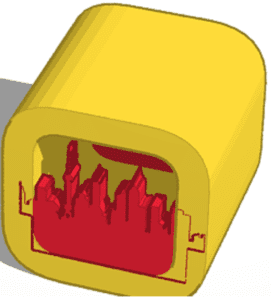 Front (unfortunately this is the only picture I have of the original design)
Front (unfortunately this is the only picture I have of the original design)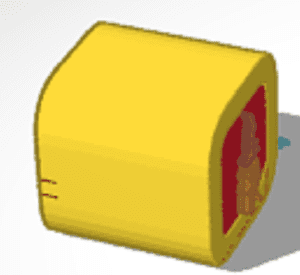 Back (extremely blurry but there are two characters in the middle of the red square)
Back (extremely blurry but there are two characters in the middle of the red square)
However, upon uploading this design to the 3D printing software, I was told that this print would take over 35 hours! So naturally, I altered the design.
At this point, I tried to minimize the design as much as possible, with a much thinner outer structure, a thinner front panel, and a thinner back lid with “carved out” ancient Chinese characters. Fortunately, this time printing took much less time, around 4 hours for the outer structure + front and 2 hours for the back lid. However, due to the style of the ancient character, some of the 3D printed areas in the middle parts of the second character had no connecting support and fell out when taking the lid off of the 3D printer.
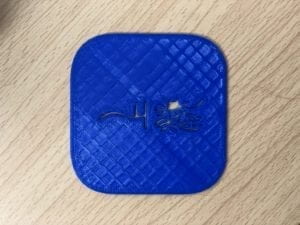 Back Lid (hole in the middle of the second character)
Back Lid (hole in the middle of the second character)
So in my third design, I changed the characters to modern Chinese characters, and added a bit of support in some spots to make sure that there would be no ‘floating’ 3D printed parts with no support. I added support to the top right, bottom right, and middle area of the 母 inside the 海 character.
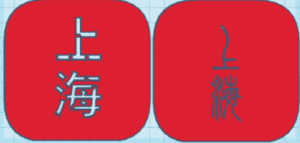 New Design on left, Original on right
New Design on left, Original on right
For the final outer structure + front, I chose this design:
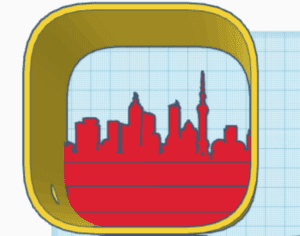 Front and Outer Structure (from Back)
Front and Outer Structure (from Back)
I planned on having the led strip at the bottom of the structure (in the picture above, the bottom is where the strip would be), and that would light up the entire structure, with the addition of tracing paper behind the Shanghai skyline (inside the outer structure) and behind the Chinese characters. However, upon implementing this, the light did not look very bright from the front and did not have the effect of a sun rising from behind the buildings.
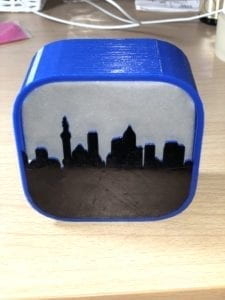 Front with tracing paper
Front with tracing paper
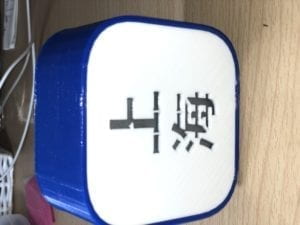 Back with tracing paper (wouldn’t rotate vertically in Documentation after trying for almost 10 minutes)
Back with tracing paper (wouldn’t rotate vertically in Documentation after trying for almost 10 minutes)
Since the original placement of the led lights did not work very well, I tinkered around a bit with the placement of the lights and decided that having them on the back lid was the best spot, this way it would seem that the sun was rising and setting behind the skyline.
For the code, I wanted to have a sunrise, bad weather, sunset, and the night lights coming on. I was able to code each of these successfully but when I tried to put them all into one long script, it got a bit buggy so I had to keep each section separated. The link to the code is below:
https://github.com/veazeylt/KL-Midterm-Shanghai-Skyline-
Presentation
The presentation went a bit better than I had originally expected, the audience seemed to like the 3D structure that I printed and the addition of the Chinese characters for Shanghai on the back lid. The sunrise and sunset were a bit too fast, and one of the members of the audience pointed out that the color choices may have been a bit too strong, particularly starting with red for sunrise. I agreed with this criticism and also think that I should have used a softer color for the sunrise. Another point given by the audience was for the nighttime sequence, the lights should flicker a bit as that is the way in the real world. This point is also valid and I believe that I should have implemented that into my code. The way I hid my Arduino and the wires could have been improved as well, a structure underneath would have been a better option for hiding them. I also think that the structure overall was a bit too thin, and if it wasn’t for adding black paper to the areas that weren’t covered with the tracing paper, the light would have seeped through the blue structure and white lid.
Below is the video and photos:
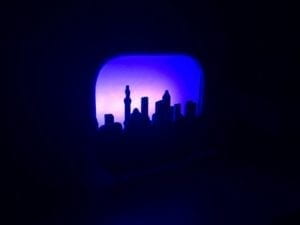 Front
Front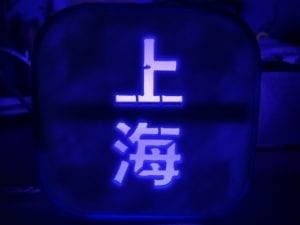 Back (some light still seeps through)
Back (some light still seeps through)
Conclusion
Throughout this project, I learned how difficult it is to 3D print the structure the way that you originally intend and that working with light can have many different ways to display this light. While I enjoyed using the tracing paper as the ‘screen’ for the light, I was also inspired by my classmates light structures to use the light to show the skyline and characters light up a dark room’s walls. While I personally think that the 3D printing was successful even if I couldn’t use my original dimensions and design, I didn’t do as well as I had hoped with coding the composition and the overall display of the structure wasn’t as good as it could have been. I believe that I could have done much more with the Neopixel lights, and with more time I would like to show a ‘week’ in Shanghai, perhaps on a much bigger structure. I enjoyed working with 3D printers for the first time in almost a whole year, and have gotten some good inspiration for my final project.